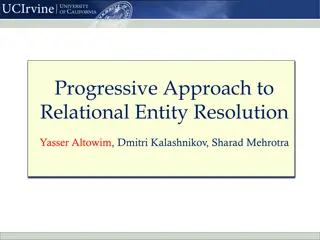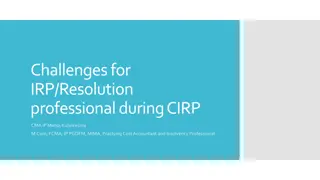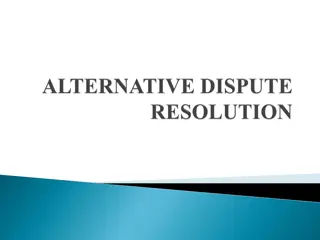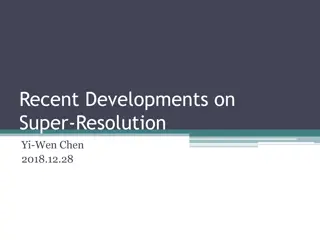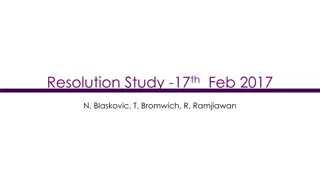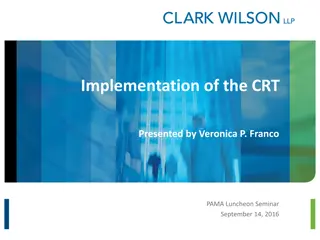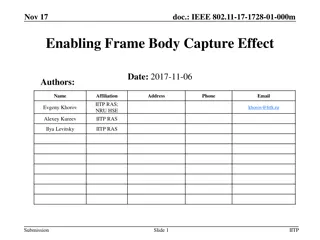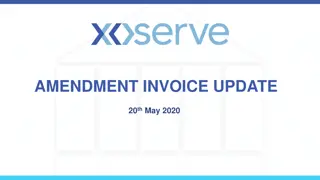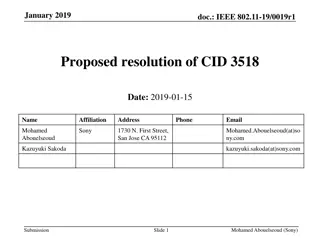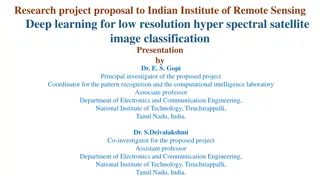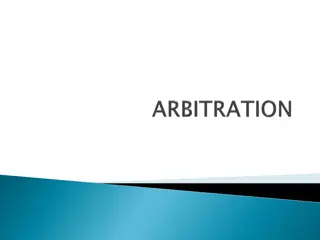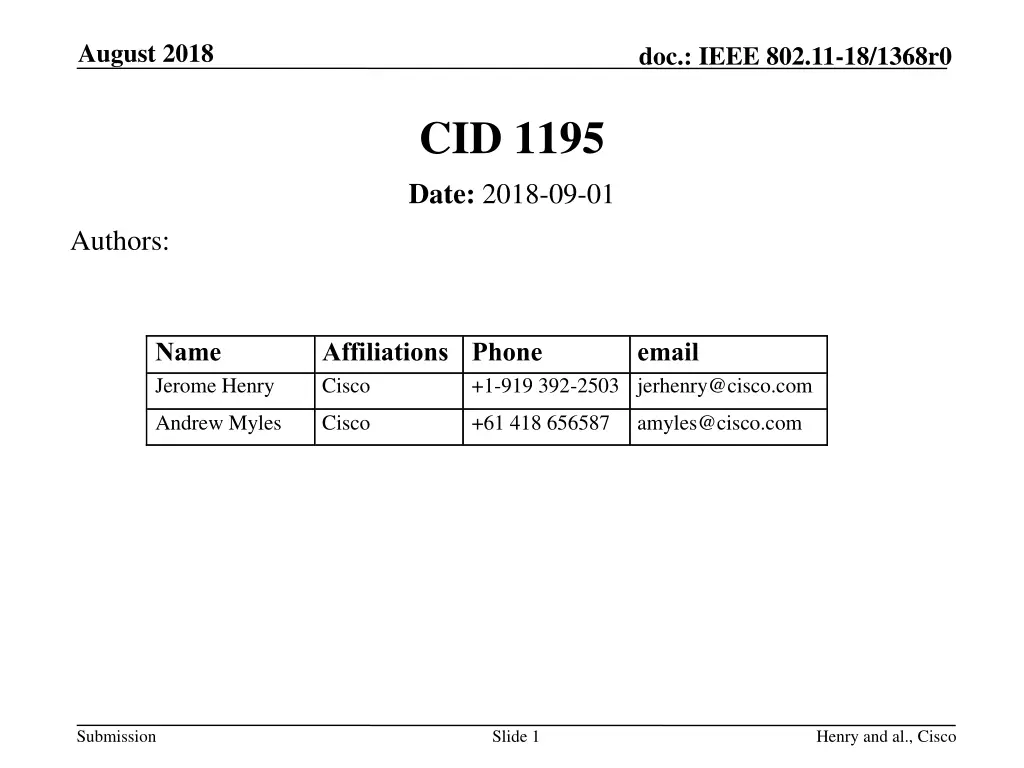
IEEE 802.11-18/1368r0 Submission on TXOP Borrowing in Wireless Networks
This submission by Jerome Henry and team from Cisco discusses CID 1195 of LB 232 and proposes a solution regarding TXOP borrowing in wireless networks, suggesting that a higher AC should be allowed to borrow TXOP time from a lower AC. The document also delves into the concept of Transmit Opportunity (TXOP) and its limitations as per IEEE standards, providing insights on differentiated service in wireless communication.
Download Presentation

Please find below an Image/Link to download the presentation.
The content on the website is provided AS IS for your information and personal use only. It may not be sold, licensed, or shared on other websites without obtaining consent from the author. If you encounter any issues during the download, it is possible that the publisher has removed the file from their server.
You are allowed to download the files provided on this website for personal or commercial use, subject to the condition that they are used lawfully. All files are the property of their respective owners.
The content on the website is provided AS IS for your information and personal use only. It may not be sold, licensed, or shared on other websites without obtaining consent from the author.
E N D
Presentation Transcript
August 2018 doc.: IEEE 802.11-18/1368r0 CID 1195 Date: 2018-09-01 Authors: Name Jerome Henry Affiliations Phone Cisco email +1-919 392-2503 jerhenry@cisco.com Andrew Myles Cisco +61 418 656587 amyles@cisco.com Submission Slide 1 Henry and al., Cisco
August 2018 doc.: IEEE 802.11-18/1368r0 Abstract This submission discusses CID 1195 of LB 232, and suggests a different solution from 18/810r1. Instead of allowing any AC to borrow the TXOP time of any other AC, only allow a higher AC to borrow TXOP time from a lower AC Submission Slide 2 Henry and al., Cisco
August 2018 doc.: IEEE 802.11-18/1368r0 Reminder on EDCA TXOPs The Transmit Opportunity (TXOP) is one of the key modifications introduced by IEEE 802.11e-2005 A TXOP is a period of time during which the TXOP owner may use the wireless medium at will As long as the duration of all transmissions of the TXOP owner and any (expected) responses to its transmissions do not exceed the TXOP limit the TXOP owner may send one or more (aggregated) frames TXOP owner Responder t TXOP duration TXOP limit Submission Slide 3 Henry and al., Cisco
August 2018 doc.: IEEE 802.11-18/1368r0 TXOP is bounded The use of TXOPs is limited by various rules One such rules is the following Frames queued at ACs other than the AC that gained access to the wireless medium must not be transmitted Clause 10.22.2.7, page 1385 of IEEE 802.11-2016: Multiple frames may be transmitted in an EDCA TXOP [ ] if there is more than one frame pending in the primary AC for which the channel has been acquired. However, those frames that are pending in other ACs shall not be transmitted in this EDCA TXOP [ ]. Submission Slide 4 Henry and al., Cisco
August 2018 doc.: IEEE 802.11-18/1368r0 18/810r1 asked a great question Why can t traffic from another AC be transmitted once traffic from the AC currently transmitting has completed, and if the TXOP still has available airtime? This submission attempts to answer this question The authors also think that it is a good idea, but with caveats Submission Slide 5 Henry and al., Cisco
August 2018 doc.: IEEE 802.11-18/1368r0 Differentiated Service in only meaningful if service is differentiated If a STA has voice traffic ready to be transmitted, EDCA gives it a higher probability of gaining medium access than a STA with AC_BE traffic ready to be transmitted This is good, because Voice is an inelastic real time application that sends packets at the rate the codec produces them [ ], should be given a low-delay queue [ ] to ensure that variation in delay is not an issue. (RFC 4594 1.5.3) Submission Slide 6 Henry and al., Cisco
August 2018 doc.: IEEE 802.11-18/1368r0 Differentiated Service in only meaningful if service is differentiated By contrast, AC_BE is typically for traffic that has not been identified as requiring differentiated treatment (RFC 4594 2.1) If AC_BE is allowed to borrow time from AC_VO access probability, now AC_VO is effectively competing against AC_BE, and AC_BE borrows some of AC_VO s differentiated service This asymptotes to removing the concept of differentiated service Submission Slide 7 Henry and al., Cisco
August 2018 doc.: IEEE 802.11-18/1368r0 A thought experiment helps use visualize the challenge Suppose a congested cell where most stations have voice and best effort traffic in their buffer If every station sends BE within VO rules, then there is effectively no differentiation anymore, only one AC 18-810r1 took a numbered example, the following slides attempt the same logic, with an opposite conclusion Submission Slide 8 Henry and al., Cisco
August 2018 doc.: IEEE 802.11-18/1368r0 VoIP vs BE Transmissions are Different VoIP and Data traffic do not have the same differentiated service requirements VoIP typically sends single frames (e.g. 160 B payload with G711) at regular interval (e.g. 20 ms with G711) BE data is anything else , not time sensitive, and with any volume requirement (e.g. large FTP transfer, BitTorrent service, or just a single telnet character) Allowing a lower AC to transmit after a higher AC but within the higher AC TXOP may be more efficient to the local STA, but it may negatively impact the general efficiency of that higher AC in the cell Submission Slide 9 Henry and al., Cisco
August 2018 doc.: IEEE 802.11-18/1368r0 Transmission of a single VoIP RT S AC_VO CT S AC K Suppose a standard single G.711 packet RTS (52 s) + SIFS (16 s) + CTS (44 s) + SIFS (16 s) + AC_VO (44 s) + SIFS (16 s) + ACK (44 s) Assuming control frames sent a 6 Mbps with legacy preamble Assuming 160 B voice payload + 28 B MAC overhead, MCS 7 20 MHz 1 SS 800 ns GI (65 Mbps) Air is free after 232 s Submission Slide 10 Henry and al., Cisco
August 2018 doc.: IEEE 802.11-18/1368r0 Frames Times Slightly different computation than 18-810, with similar assumptions RTS = 20 + 4*ceil((20*8+22)/24) = 52us where 20 = 8LSTF+8LLTf +4LSIG 4 = 4us 20 = 20B for RTS 8=8b/B 22 = 16Service+6Tail 24 = 6Mbps * 4us CTS = 20 + 4*ceil((14*8+22)/24) = 44us Voice = 20 + 4*ceil(((160+28)*8+22)/(65*4)) = 44us Ack = same as CTS Submission Slide 11 Henry and al., Cisco
August 2018 doc.: IEEE 802.11-18/1368r0 Backoff durations Assuming initial transmission attempts succeed AIFS = AIFSN 9 s CW = [0 CWmin], average CW = CWmin AC_VO: 47.5 s (16+9x7/2) Next STA can send at t = 232 + 47.5 = 279.5 s Submission Slide 12 Henry and al., Cisco
August 2018 doc.: IEEE 802.11-18/1368r0 Transmission of a single BE burst RT S AC_BE AC_BE AC_BE CT S AC K AC K AC K Suppose an FTP transfer, 2528 s TXOP RTS (52 s) + SIFS (16 s) + CTS (44 s) + SIFS (16 s) + 8x(AC_BE (208.4 s) + SIFS (16 s) + ACK (44 s)) Assuming control frames sent a 6 Mbps with legacy preamble Assuming 1500 B payload + 28 B MAC overhead, MCS 7 20 MHz 1 SS 800 ns GI (65 Mbps) Air is free after 2275.2 s Submission Slide 13 Henry and al., Cisco
August 2018 doc.: IEEE 802.11-18/1368r0 Transmission of a BE burst within an AC_VO TXOP RT S AC_VO AC_BE AC_BE CT S AC K AC K AC K The VoIP part still consumes 232 s Then: SIFS (16 s) + 6x(AC_BE (208.4 s) + SIFS (16 s) + ACK (44 s)) AC_VO duration is 2080 s Air is free after 1842.4 s Submission Slide 14 Henry and al., Cisco
August 2018 doc.: IEEE 802.11-18/1368r0 Once a Transmission Completes, what are the chances that the next transmission in the cell will be AC_VO (or AC_BE)? Next STA with AC_VO traffic has to wait: AIFSN[AC]+RAND(0,3) = 18 to 45 s Next STA with AC_BE traffic has to wait: AIFSN[AC]+RAND(0,15) = 27 to 162 s AC_VO STA is likely to send (p=86.7%) Submission Slide 15 Henry and al., Cisco
August 2018 doc.: IEEE 802.11-18/1368r0 These computations are simplified approximations Adding more stations with more traffic types in their queue makes the computation more complex, less deterministic a) backoff is exponential with retries (higher client density implies more retries) b) This submission (and 18-810) assume CWMin, but wait time is in fact a distribution usually one STA will start earlier, if there is more than one STA. Also, critically, backoff time is *shared* between STAs. c) 16 + 9us * CWmin/2 is some kind of upper bound for lightly loaded networks only. However, this simple model allows for a simple impact evaluation Submission Slide 16 Henry and al., Cisco
August 2018 doc.: IEEE 802.11-18/1368r0 How delayed is the next voice packet? If 2 STAs have a voice packet to send, and one wins the medium access: STA2 may have to wait about 280 s (then has 87% chance of getting the next airtime slot) If STA1 is permitted to fill its AC_VO TXOP with other AC traffic, now STA2 may to wait about 1840 s (then has 87% chance of getting the next airtime slot) Allowing upper AC hijacking can multiply wait time by close to 7! Submission Slide 17 Henry and al., Cisco
August 2018 doc.: IEEE 802.11-18/1368r0 Does it matter? Delaying a single packet may seem insignificant That BE packet will need to be sent sooner or later anyway However, Voice is real time Packets are timestamped In most networks, a next packet delayed by more than 30 ms (compared to the previous packet timestamp) is discarded Each STA with VoIP packet coming into its transmission buffer must be given a high opportunity to be sent fast A voice packet will come into the buffer every 20 ms time budget between packets: 20 ms Submission Slide 18 Henry and al., Cisco
August 2018 doc.: IEEE 802.11-18/1368r0 How Many voice calls can my cell support? With AC_VO offered a differentiated service (current method) 279.5 s between voice packets with 87% access chance seems to indicate support for a large number (107 packets per 30 ms!) In fact, overhead (beacon and others) reduces the available airtime A single STA sends 1 VoIP packet every 20 ms AC_BE access chances and collision chances follow a standard Poisson distribution Common designs call for 20 to 25 active calls per cell Submission Slide 19 Henry and al., Cisco
August 2018 doc.: IEEE 802.11-18/1368r0 How Many voice calls can my cell support? If lower AC piggy back within an AC_VO A single AC_VO burst now occupies 1842.4 s A contending AC_VO STA may need to wait 1890 s (1842.4+47.5), then contends with 87% chances to transmit (against AC_BE) But even in perfect conditions (no AC_BE win, no overhead [beacons etc.]), 16 calls saturate the 30 ms airtime space But a single STA sends one packet every 20 ms, there is only space for 10 calls within that space We are back to the VoIP efficiency of 802.11b (10 calls max) Submission Slide 20 Henry and al., Cisco
August 2018 doc.: IEEE 802.11-18/1368r0 Conclusion 1 Allowing a lower AC to transmit into an AC with higher priority degrades the differentiated service offered to the higher AC The consequence is effectively to transmit most traffic in the highest active AC and tends to suppress the Differentiated in DiffServ A complex application and station mix makes the picture of real networks more complex But the general conclusion that allowing a lower AC to borrow time from a higher AC results in less time for the higher AC Submission Slide 21 Henry and al., Cisco
August 2018 doc.: IEEE 802.11-18/1368r0 However, 18-810 raises another great point A successful TXOP is a precious resource In terms of overhead, receiving access to the wireless medium may be costly Collisions easily increase overhead to significant levels Once a TXOP has been acquired it should be used to the full extent Under high load, the competition for TXOPs must be reduced since otherwise efficiency decreases Submission Slide 22 Henry and al., Cisco
August 2018 doc.: IEEE 802.11-18/1368r0 The main issue is gaining the access AIFSN + random backoff consume time Higher priority AC prioritization cannot be deterministic in a CSMA/CA system We cannot say wait AIFSN=0 if AC_VO has to send Collision rates would dramatically increase We cannot say CW=0 for AC_VO Collisions would be guaranteed We need a waiting system to distribute access, but need to ensure that AC_VO gets access with minimum delay Submission Slide 23 Henry and al., Cisco
August 2018 doc.: IEEE 802.11-18/1368r0 Once access is gained, using it makes sense However, once a lower AC has gained access, allowing the same STA higher AC to leverage that same TXOP makes sense Collisions are already avoided by the access method We can provide differentiated service to the higher AC without collision risk Submission Slide 24 Henry and al., Cisco
August 2018 doc.: IEEE 802.11-18/1368r0 Proposed additional text Modify restriction on use of a primary AC s TXOP IEEE 802.11-2016, Clause 10.22.2.7 (Multiple frame transmission in an EDCA TXOP), page 1385 Additional rules are needed describing that sharing with higher AC is permissible if the traffic of the AC that gained medium access was transmitted over the medium Submission Slide 25 Henry and al., Cisco
August 2018 doc.: IEEE 802.11-18/1368r0 References 1. G. R. Hiertz, CID 1195, IEEE 802.11 submission 11- 18/810r1, Sep. 2017. 2. J. Henry and A. Myles, QoS mapping comment for 802.11md Letter Ballot, IEEE 802.11 submission, 11- 18/354r1, Feb. 2018. 3. Cisco, Voice Over IP - Per Call Bandwidth Consumption, Apr. 2016. [Online]. Available: https://www.cisco.com/c/en/us/support/docs/voice/voic e-quality/7934-bwidth-consume.html Submission Slide 26 Henry and al., Cisco

